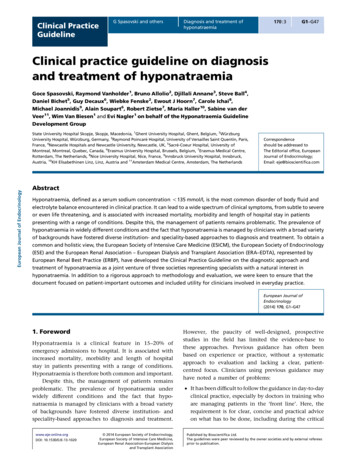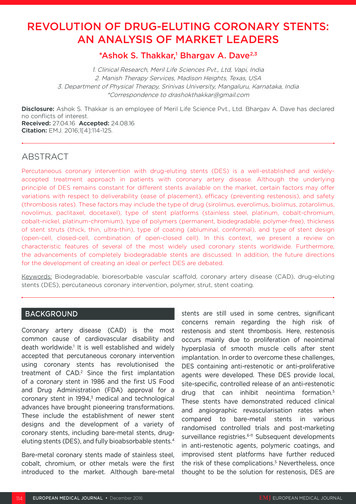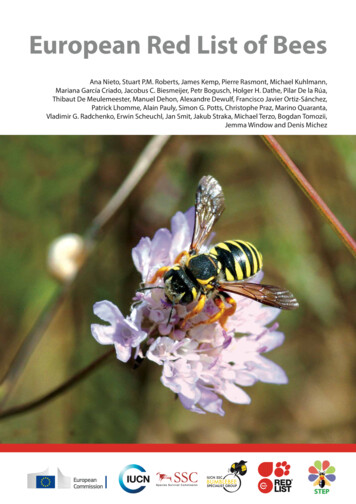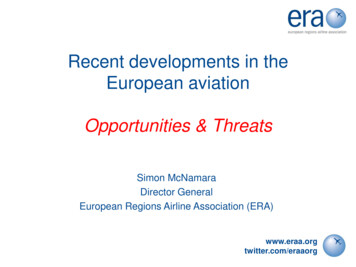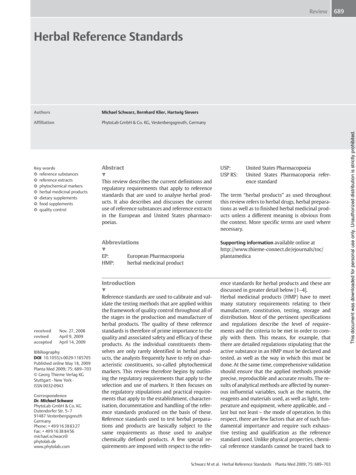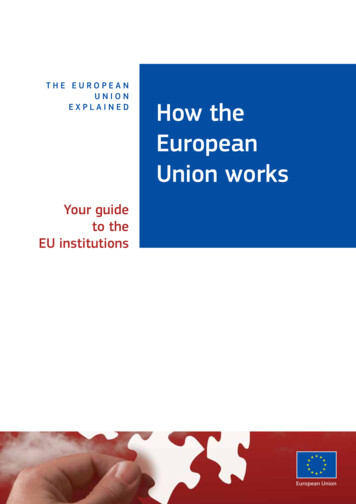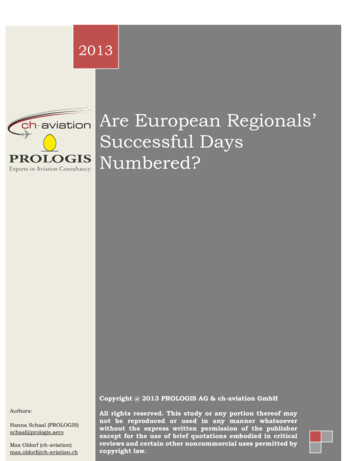
Transcription
2013Are European ReJLRQDOV· Successful DaysNumbered?Copyright @ 2013 PROLOGIS AG & ch- aviation GmbHAuthors:Hanna Schaal (PROLOGIS)schaal@prologis.aeroMax Oldorf (ch- aviation)max.oldorf@ch- aviation.chAll rights reserved. This study or any portion thereof maynot be reproduced or used in any manner whatsoeverwithout the express written permission of the publisherexcept for the use of brief quotations embodied in criticalreviews and certain other noncommercial uses permitted bycopyright law.
UH (XURSHDQ 5HJLRQDOV· Successful Days Numbered?33.33% of all regional carriers inEuropewentoutofbusinessbetween 2008 and today, nearlyone fourth of the employees losttheirjobs.PROLOGISandch- Figure 1DYLDWLRQ KDYH VFUXWLQL]HG (XURSH·V regional airline market.'RHVQ·W LW VRPHWLPHV IHHO OLNH (XURSH·V UHJLRQDO DLUOLQHV· PDUNHW H[LWV DUH asFRPPRQ DV WKHLU HQWULHV" 'RQ·W \RX occasionally wonder if this industry stillbears any potential? In order to gainclarity in this matter, PROLOGIS and ch- aviationconducted a studyFigure 2of theEuropean regional market, comparingThedata from 2008 with data from 2013.PartnershipsThe results are quite frightening: 44 newIt all started in the early days with theairlines were founded from 2008 on, 22traditional regional carrier model, whichof them have already vanished. Theis still very popular today. Affiliatedoverall mortality rate was 33.33% (seeDLUOLQHV VXSSO\ RU ¶IHHG· ODUJH QHWZRUN Figure 1). But the most concerningFDUULHUV· KXEV ZLWK SDVVHQJHUV IURP number is probably a job loss rate of 23small, nearby regional airports. In many% between 2008 and today, whichcases, the relationship between networkmeansfourthairlines and the subcontractors is basedemployee lost his job (see Figure 2). Iton a parent- subsidiary model, with theVHHPV OLNH UHJLRQDO FDUULHUV· VXFFHVVIXO affiliates operating either under theirdays are ndlingregionalbrand.Lufthansa, for example, currently hasfour regional partners (Air Dolomiti,CityLine,March 19, 2013EurowingsandAugsburgPage 1
Airways), all 100% subsidiaries with theAll three major European carrier groupsexception of Augsburg Airways thatnot only face increasing pressure fromtogetherRegional.still fast growing low- cost carriers forAirwaystraffic within Europe. They also feelformNevertheless,LufthansatheAugsburgregional partnership will be terminatedcompetitionfromDW WKH HQG RI /XIWKDQVD·V VXPPHU internationalcarriers,schedule 2013 after 16 years due to theserving smaller European markets, from*HUPDQ OHJDF\ FDUULHU·V UHVWUXFWXULQJ hubs in the Middle East for example.SURJUDP ¶6FRUH·.1 Along with the previousThese factors have led to lower yields fortermination of the equally longstandingpoint- to- point regional traffic and lowerpartnership with Contact Air in Octoberdemand for hub and spoke traffic within2012, the German airline will haveEurope as well as for intercontinentalparted from two regional partners withinflights. This makes it difficult to continueonly a year.profitable regional operations with smallA similar decrease in regional affiliatedpartnerships can be observed at AirFrance- KLMandIAG(InternationalAirlines Group, holding company ofexpandingincreasinglyaircraft.The Independents ² DecreasingProfits?British Airways & Iberia). To cut costs,Flybe. ² the keyword that reminds usAir France will be merging the threethatregionals Airlinair, Brit Air and Régionalcarriers, we are not only referring toXQGHU D VLQJOH QHZ EUDQG FDOOHG ¶ RS · DV affiliates. Since the mid- 1990s, thereof March 31, 2013, that will operate mosthave been a growing number of totallynon- hub routes with a low- cost carrierindependent carriers that offer point- to- like product offering.2 British Airwayspoint service to both small regional andalready sold its regional BA Connect tolarge international airports, operatingBritish regional Flybe. in March 2007, asunder their own brands and with no tiesthemanagement did QRW VHH DQ\ to large network carriers. Since theprospect of profitability in its currentacquisition of BA Connect in 2007 weIRUPµ3 anymore.MXVW PHQWLRQHG )O\EH LV (XURSH·V 312whenwetalkaboutregionalU.S. Securities and Exchange Commission (2006)ch- aviation (2012)ch- aviation (2013a)March 19, 2013Page 2
largest regional carrier in general. ForRUGHU WR DQDO\]H (XURSH·V UHJLRQDO the six months until 30 September 2012,carrier market and its developmenthowever, the group that includes Flybe.within the last five years, we comparedNordic (a joint venture with Finnair)airline and fleet data from January 1,reported a pre- WD[ ORVV RI P ½ P 2008, with current data (date of dataFlybe. blamed the results on fuel pricesanalysis: February 17, 2013). Regionally,at record highs and a decrease inthe scope of the study includes all EUpassenger numbers in the UK domesticmember states plus Albania, Bosnia- aviationHerzegovina, Croatia, the Faroe Islands,market.4TheNorwegianregional Widerøe, that is still fully ownedIceland,by SAS (with a sale expected this year5),Montenegro,but operating fairly independently, wasSwitzerland. The underlying data for theselected European Airline of the Yearstudy is based on a combination of the2012 by the ERA (European Regionalch- aviation airline knowledge base, jpAirline Association). Yet, the awardairline- fleets and manual research byFDQQRW KLGH WKH IDFW WKDW WKH FDUULHU·V ch- aviation.operating profit decreased by 59.8%Norway,Serbiatotal of 195 regional2012. Other European independentsoperatedmust deal with financial results similarandintheairlines havecountriesunderconsideration, of which only 130 carriersWR )O\EH ·V DQG :LGHU¡H·V inMacedonia,During the time period we observed abetween December 2011 and OctoberRegionalsKosovo,are still active today. This means a lossEurope:of 65 regional airlines over the last fiveOverallyears, reflecting a significant mortalityAnalysis Resultsrate of 33.33% (see Table 1). This rate isHow did we obtain our results and whateven more alarming when we only look atdo they look like in greater detail? Inthe carriers entering the market betweenActive before 2008active in 2013Airl inesM ortal ityActive in 2013Founded from 2008 onw ent out ofbusiness betw .2008 and 2013active in 2013108430108w ent out ofbusiness betw .2008 and 2013TOTALPercent2222195 100.00%430226533.33%- 22- 13066.67%Table 1, Regional Airline Development in Europe (2008- 2013)4Flybe.com (2012)March 19, 20135ch- aviation (2013b)Page 3
2008 and today: Every second newlyindependents ( 74.87%) amounting to afounded carrier was unable to survive.ratio of 1:3 (see Figure 4).The numbers look a bit better for theairlines that already existed before 2008.Of all 151 regionals that existed before2008, 108 (71.52%) are still operating.They represent more than three quarters(83.0 RI WRGD\·V DFWLYH FDUULHUV To sum things up, there has been amajor airline decline over the last fewFigure 3years. The regional market in Europe inparticular does not seem promising tostart- ups.Moreover,itshouldbementioned that the decline of regionalairlineshasanegativeeffectonsecondary airports, frequently the basesof regionals. The cessation of a carriercan result in a drastic reduction inairport business volume, making itsFigure 4,future uncertain.AffiliatesversusIndependents:Converging RatioThedistinctWith regard to affiliates and pendent carriers revealed a current1:2 ratio (42 affiliates/network carrierswith regional operations 32.31%, 88independents 67.69%;; see Figure 3).This ratio has converged. In total,between 2008 and 2013, there were 49affiliates/network carriers with regionaloperations( 25.13%)March 19, 2013* Total of all airlines that have beenoperating in 2008 & were foundedfrom 2008 on (including airlinesthat have gone out of tionsownregionalhavebeencomparably low over the last five years.Only two new airlines were foundedbetween then and now that fall in thiscategory, Cimber which launched in2012 and Olympic Air in 2008. BothZHUHQ·W QHZ PDUNHW SDUWLFLSDQWV LQ WKH proper sense, but rather successors:CimberevolvedfromtheinsolventPage 4
Cimber Sterling (and works closely withthis category from their contracts withSAS) and Olympic Air from OlympicregionalAirlines.moving14.29% of the affiliates withdrew fromthe market. In contrast, 39.73% of theindependents have gone out of business.Consideringonlyindependents,thehighest mortality rate could be observedbetween the years: A total of 42 gionalDLUFUDIW /XIWKDQVD·V UHJLRQDO DIILOLDWHV have retired 60 50- seat aircraft in fiveyears, as Lufthansa has decided to dropall of these aircraft and now to also dropall 70 seat turboprops by the end of2013.were founded from 2008 on, yet 55% ofthem have failed.Fleet DevelopmentHow have fleets changed over the pastfive years? In 2008, 706 aircraft with 20- 50 seats were operated by Europeanregionals. Within five years, this numberFigure 5decreased by 53.26% to 330. There wasAnd yet, it was small regional jets likealso a decrease in the number of aircraft%RPEDUGLHU·V &5-- RU (PEUDHU·V with less than 19 seats (by 13.79%).ERJ- 145 that replaced turboprops in theOnly the amount of 50- 100 seatersmid- nineties. They made flying bothincreased by 3.37% from 682 to 705 (seeshort and long routes with just a fewFigure 5). In summary, we can observe apassengers more economical and weretrend away from aircraft with fewer thanconsidered50 seats towards aircraft with 50- 100passengers,seats.stepping stones into profitability formanyIt is expected that the demise of 37- 50seat regional jets in Europe will comesoonerratherthanlater.Thiscorresponds with a similar developmentin the United States where major carriersare currently slashing regional jets inMarch 19, itutingHowever,triggered by the post- 9/11 recession, theEHORZ VHDW MHWV· VXFFHVV VWDUWHG JRLQJ south. Regional airlines that also oftenface competition from low- cost carrierslaunching the same or similar routeswith a completely different businessPage 5
model began moving towards larger50 seats are being offered anymore withregional jets and back to turboprops (asthe ATR42- 600 being the only 50 seatnew aircraft types with lower per seatturboprop still for sale. (See Figure 6 andcosts have become available).AppendixAt some point, the costs of operating 50seat jets could not be justified any longerforregionalaircraftdevelopment.)The victims: Employeesafter the fuel prices exploded coupledwith the global financial crisis.6 In orderThe preceding analysis results clearlyto distribute fix costs over a higherLOOXVWUDWH amount of seats, the majority of thedownturn in Europe. And, as usual, thecarriers now focus on operating large 90- UHFHVVLRQ·V SDLQ LV IHOW PRVW E\ theplus seat jets like the ERJ195 or CRJ- employees.900 or slightly smaller turboprops likethe ATR72- 600 or Bombardier Dash 8- Q400 where routes justify the use ofthese aircraft. Other routes are eitherdropped altogether or picked up by othercarriers operating smaller turbopropaircraft (that will face a problem of theirown due to the lack of fleet replacementoptions) as no new turboprops with 20- WKH UHJLRQDO PDUNHWV· When analyzing the development of jobsLQ (XURSH·V UHJLRQDO DLUOLQH LQGXVWU\ ZH made a distinction between direct andindirect airline jobs. Direct jobs referonly to the aircrew needed to operate theaircraft,thatispilotsandflightattendants. Indirect jobs include allother jobs in operations, administrationand engineering. Based on PROLOGISand ch- aviation estimates, there were15,118 direct regional airline jobs withintheEUandtheotherEuropeancountries we analyzed in 2008. By thebeginning of 2013, this number haddropped to 11,930 (a decrease of 21%).Duringthesamefiveyearperiod,indirect jobs were reduced by 8,996 fromFigure 66Oliver Wyman (2010)March 19, 2013Page 6
38,486 to 29,490, accounting for aall of these new airline start- ups everydecrease of 23%.year. This raises the question: Are theBased on a sample of 20 affiliatedregional carriers and 20 independents,regionals in Europe currently employ atotal of 36 direct and indirect employeesper aircraft on average. In total, 12,184regional airline jobs were lost in theEuropean regions we evaluated. From arational perspective, this means thatover the last five years seven jobs werelost every day. This number probablyUHIOHFWV WKH GUDPDWLF GURS LQ (XURSH·V regional aviation industry better thanany previous figures referred to in thisarticle.founders and investors in all of thesenew regional market participants awareof the high risks and low chances ofsuccess?Havetheyrecognizedtheconsequences that come along with afailing attempt? And, if so, what is theirmotivation to still keep trying to enterregional markets with new ventures? IWHU VFUXWLQL]LQJ (XURSH·V UHJLRQDO FDUULHUV· GHYHORSPHQW RYHU WKH SDVW ILYH years, we believe that this industry isindeed quite challenging at its currentstage. Nevertheless, there still seems tobe room for growth in some regionalniche markets.When carriers are located at or fly toregions where alternatives are limited ornonexistent, there still is potential.Carriers like Direktflyg, Malmö Aviation,Nextjet and virtual operator SverigeflygmainlyfocusonScandinavianFigure 7Conclusion and mestic flights and routes to Greenlandand the Faroe Islands. These are a fewEstablishing a new airline, no matterindependent carrier examples with lowwhether it is a regional, low cost orcompetition from other carriers or modesnetwork carrier, is a huge challenge andof transportation which seem to work onanything but a guarantee of financialtheir own or thanks to public servicesuccess. However, we are still observingobligation schemes with governmentMarch 19, 2013Page 7
support in place to serve remote regionseffectively. But most regions in Europedo not offer such niche conditions. Andif not sheltered from competition forwhatever reason (geographically, airportconstraints etc.), regionals quite oftenhave trouble keeping up with low- costcarriers from a competitive l perspective to effectivelywork closely, with large haring, through check- in). So, asnetwork carriers drop regional routes,the point to point demand on theseroutes is often insufficient for an existingor new regional carrier without networkconnectivity to take them over. Thus, itis often unlikely that these routes will beserved again.In conclusion, the current situationwithiQ (XURSH·V UHJLRQDO DLUOLQH PDUNHWV is no bed of roses unless independentcarriers can make use of one of the fewprosperous niches to settle, thrive andprosper in.March 19, 2013Page 8
Appendix More than 20deliveries/yearof a series(e.g. Fokker70/Fokker 100,EMB- 190/EMB- 195)Data source:ch- aviationWorldwide deliveries of regional aircraft 1990- 2012 (sorted smallest to largest seat capacity)AircraftEMB120Jetstream 4 1Do328- ‐3 00Do328- ‐1 00ERJ135S340 AS340 BDHC- ‐8 - ‐1 00DHC- ‐8 - ‐2 00ERJ140ERJ145ATR42- ‐3 00ATR42- ‐4 00ATR42- ‐5 00ATR42- ‐6 00CRJ100CRJ200DHC- ‐8 - ‐3 00F27 M K050F27 M K060MA- ‐6 0S2000BAe ATPATR72- ‐2 00ATR72- ‐5 00ATR72- ‐6 00CRJ700EMB- ‐1 70DHC- ‐8 - ‐4 00An- ‐1 48Fokker 7 0EMB- ‐1 75B.146- ‐1 00CRJ900ARJ70SSJ 1 00CRJ1000EMB- ‐1 90ARJ85B.146- ‐2 00EMB- ‐1 95Fokker 1 00B.146- ‐3 00ARJ100Grand TotalMarch 19, etJetJetJetSeats 1990 1991 1992 1993 1994 1995 1996 1997 1998 1999 76211392292316134445014336381 24981041061125311151710117112695118122 2545536833154123 16161334112851178411127302 313 272 257 233 297 293 253 286 301 3742001 2002 2003 2004 2005 2006 2007 2008 2009 2010 2011 2012 Grand 214173371289113351113411104223616175106 8561904714710752473313027552658755361128123164125 137 156 109 2013101420172423112243535171432 393 351 373 320 288 340 409 250 284 306 2617288Page 9
Referencesch- aviation (2012). http://www.ch- aviation.ch. October 26, 2012. http://www.ch- aviation.ch/portal/news/14101- lufthansa- cancels- augsburg- airways- wet- lease- agreement (accessed March 15, 2013).ch- aviation (2013a). http://www.ch- aviation.ch. February 2, 2013. http://www.ch- aviation.ch/portal/news/16507- hop- to- take- over- air- france- regional- routes- from- march (accessed March 15, 2013).ch- aviation (2013b). http://www.ch- aviation.ch. March 11, 2013. http://www.ch- aviation.ch/portal/news/17395- sas- sets- up- swissport- ground- handling- jv- sees- demand- for- widere- sale (accessed March 15, 2013).Flybe.com (2012). https://www.flybe.com. November 8, 2012.https://www.flybe.com/corporate/pdf/Flybe- Group- plc- Half- year- report- September- 2012.pdf (accessed March 15, 2013).Oliver Wyman (2010). http://www.oliverwyman.com. 2010.http://www.oliverwyman.com/media/OW EN AAD PUBL 2010 50 Seat Jet.pdf (accessed March 15, 2013).U.S. Securities and Exchange Commission (2006). http://www.sec.gov. November 23/000119163806002648/bay200611036k3.txt (accessed March 15, 2012).March 19, 2013P a g e 10
Table 1, Regional Airline Development in Europe (2008M2013) active in 2013 went out of business betw. 2008 and 2013 active in 2013 went out of business betw. 2008 and 2013 Airlines 108 43 22 22 195 100.00% Mortality 0 43 0 22 65 33.33% Active in 2013 108 M 22 M 130 66.

